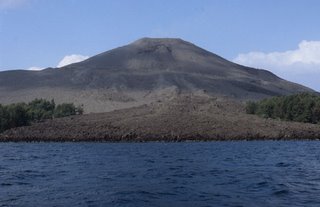I am writing this blind in pitch darkness. We are under a continual rain of pumice-stone and dust. So violent are the explosions that the ear-drums of over half my crew have been shattered. My last thoughts are with my dear wife. I am convinced the Day of Judgement has come.
Captain Sampson, ship's log, Norham Castle
 On 27 August 1883, the Indonesian volcano Krakatau erupted, killing 40,000 people in nearby Java and Sumatra. The force of the explosion shattered the volcano, leaving only a narrow crescent—a fragment of the cone—intact. Hot ash and lava covered what little remained of Krakatau and sterilised the neighbouring islands of Sertung and Panjang. Nothing survived.
On 27 August 1883, the Indonesian volcano Krakatau erupted, killing 40,000 people in nearby Java and Sumatra. The force of the explosion shattered the volcano, leaving only a narrow crescent—a fragment of the cone—intact. Hot ash and lava covered what little remained of Krakatau and sterilised the neighbouring islands of Sertung and Panjang. Nothing survived. Three years later, Dutch biologists visiting the island (now called Rakata) found two species of moss, eleven species of ferns and fifteen species of flowering plants growing on the crumbling lava. Within thirteen years of the eruption, over fifty species of plants, including figs (Ficus septica, F. hispida and F. padana) and the fast-growing macaranga (Macaranga tanarius) had established themselves. Today, Rakata, Sertung and Panjang are mantled in forest, the seeds of which have been brought in on the tide, in bird and bat faeces or by human agency.
Three years later, Dutch biologists visiting the island (now called Rakata) found two species of moss, eleven species of ferns and fifteen species of flowering plants growing on the crumbling lava. Within thirteen years of the eruption, over fifty species of plants, including figs (Ficus septica, F. hispida and F. padana) and the fast-growing macaranga (Macaranga tanarius) had established themselves. Today, Rakata, Sertung and Panjang are mantled in forest, the seeds of which have been brought in on the tide, in bird and bat faeces or by human agency. Krakatau did not blow itself out of existence in 1883. A new volcano, Anak Krakatau (child of Krakatau) emerged from the sea. The pattern of colonisation along its shore resembles that of Rakata—as far as it can. Nothing here is simple. Rakata's forests remain undisturbed, no longer subject to heat and lava. The trees grow, providing food and habitat for other organisms. More and more species gain toeholds and become established. But Anak Krakatau is another story. Periodic volcanic activity incinerates plants and animals with lava flows. This photo shows the fate of a fringe of she oaks and other coastal vegetation following an eruption.
Krakatau did not blow itself out of existence in 1883. A new volcano, Anak Krakatau (child of Krakatau) emerged from the sea. The pattern of colonisation along its shore resembles that of Rakata—as far as it can. Nothing here is simple. Rakata's forests remain undisturbed, no longer subject to heat and lava. The trees grow, providing food and habitat for other organisms. More and more species gain toeholds and become established. But Anak Krakatau is another story. Periodic volcanic activity incinerates plants and animals with lava flows. This photo shows the fate of a fringe of she oaks and other coastal vegetation following an eruption.
(Remind me later and I'll tell you how it feels to take a photo of an erupting volcano from not far enough away.)
Read more
Thornton, I. (1996). Krakatau: The destruction and reassembly of an island ecosystem. Harvard University Press.
Winchester, S. (2003). Krakatoa: The day the world exploded. Penguin.